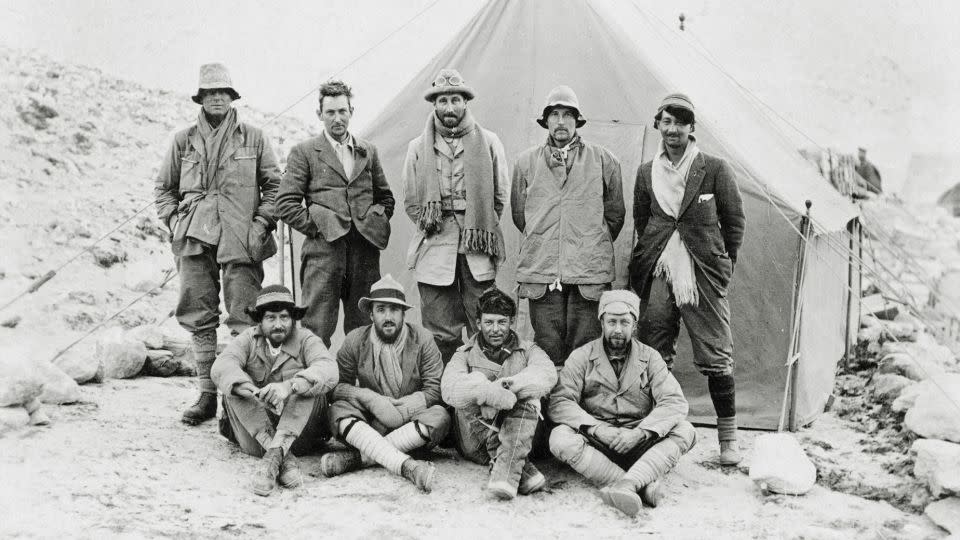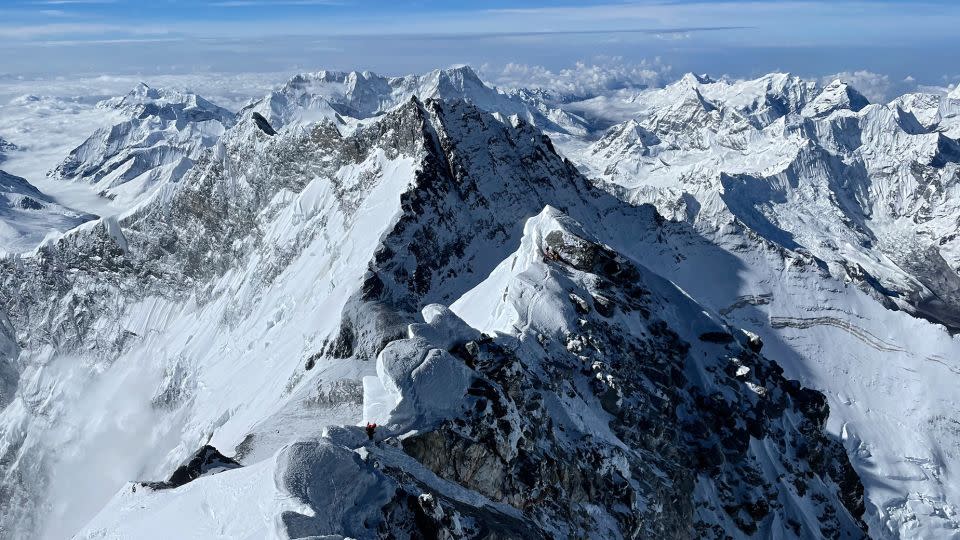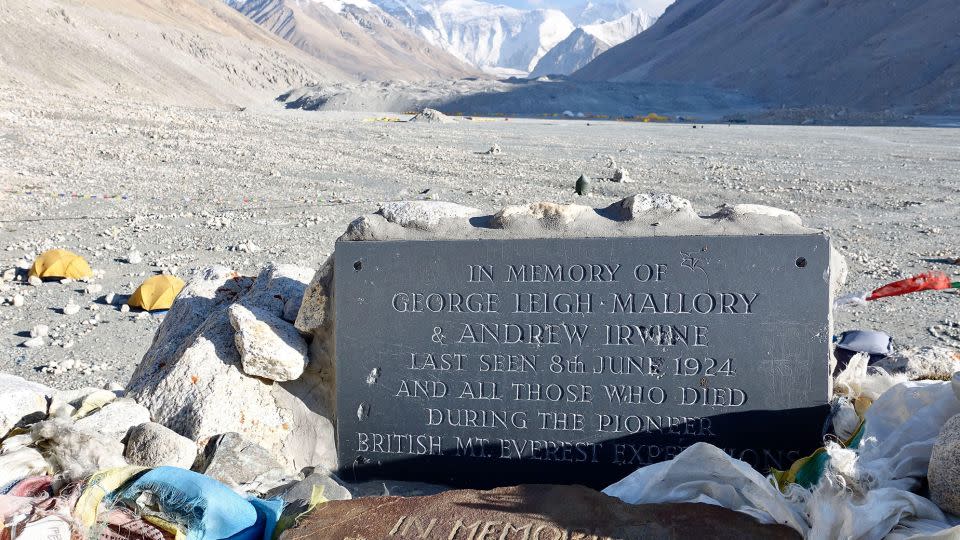100 years ago they disappeared on Everest. But did they make it to the summit?
- Oops!Something went wrong.Please try again later.
It’s one of climbing’s greatest mysteries: was Everest really conquered for the first time in 1953, or did two mountaineers make it to the summit in 1924, before dying in mysterious circumstances?
British climbers George Mallory and Andrew “Sandy” Irvine were last seen on June 8, 1924, 800 feet below the peak, before disappearing into clouds. They never reemerged.
When Mallory’s body was found in 1999, hopes were high that it might give a clue as to whether the pair reached the summit. But, tantalizingly, the camera he had been carrying – with which he would have documented the highest point they had reached – was not on the body. Irvine’s body has never been found.
But now, as the 100th anniversary of the mens’ disappearance approaches, one researcher believes that he has solved mountaineering’s greatest mystery.
By studying the expedition weather reports, author Graham Hoyland believes that he has worked out what happened to the pair – and whether they made it to the summit before they died.
Hoyland – a distant relative of another member of the expedition group, who has visited on Everest nine times searching for the remains – believes that the key to the mystery is air pressure.
His relative several times removed, Howard Somervell – another mountaineer, who had got within 1,000 feet of the summit on the same expedition before a lack of oxygen meant he had to retreat – was responsible for tracking the weather during the expedition.
The smoking gun?

His records – which he submitted after the official report on the 1924 expedition was made, having returned to his job as a surgeon in India – show that the barometric pressure dropped between the morning of June 8 and June 9 at base camp, where Somervell was taking the readings.
Somervell recorded the pressure in inches of mercury, dropping from 16.25 to 15.98. Hoyland believes that these figures equate to a 10 millibar drop in pressure. Weather-related deaths on Everest are generally associated with a drop in barometric pressure at the summit.
A decrease of just 4 millibars can trigger hypoxia; a 6 millibar drop was enough to cause the incident in 1996 in which 20 people were trapped on the mountain, eight of whom died. That story is recounted in writer Jon Krakauer’s book “Into Thin Air.” The bad weather angle was also explored in a 2010 paper by experts from the University of Toronto, led by G.W. Kent Moore.
“They were climbing into an absolute s***storm – not only a blizzard but a sort of snow bomb,” Hoyland told CNN. Hoyland has experienced “snow bombs” himself on Everest. “It’s terrifying – the temperature drops hugely, you’re gasping for breath. There are winds of 100 knots. One guy I know was blown off the mountain, and ended up further up the mountain,” he said.
Effectively, the drop in air pressure meant that the mountain suddenly became higher – around 650 feet higher, to be precise. Hoyland calls it “an invisible death trap.”
The pair – who were ascending along the northwest ridge – were already climbing against the odds. Mallory wrote in a letter to his wife that he put his chances of making the summit at 50 to one. Hoyland thinks it was more like 20 to one. But, he thinks, they would have had no idea what was about to hit them.
“Mallory had seen Norton and Somervell get to to within 1000 feet of the top on 4 June using no oxygen equipment; it would have seemed reasonable to assume that it was possible to reach the summit with the apparatus,” he writes in a forthcoming book.
“What he didn’t know was that the rapidly falling air pressure was effectively making the mountain even higher.
What’s more, the storm and blizzard wouldn’t just have made a drop in air pressure. The pair were wearing layers of silk, cotton and wool. Hoyland – who had a similar made-to-measure outfit on an Everest trip – says that the clothes are exceptionally comfortable but wouldn’t have provided the warmth to survive a blizzard or an overnight.
Previously, it has been speculated that the pair had reached the summit before dying on the way down, something that Hoyland calls “wishful thinking.”
“I’d been trying to prove that Mallory had climbed Everest for years and years – I wanted to prove that I was the 16th Briton to climb it, not the 15th. But unfortunately when you read facts and they’re different, you have to change your mind. You can’t carry on being a wishful thinker,” he says.
Until Hoyland, nobody had closely studied at the weather reports, which were held at the Royal Geographical Society in London.
The summit was eventually reached by Edmund Hillary, a New Zealand mountaineer, in 1953 – the first documented ascent of the peak.
A century of speculation

The mystery of Mallory and Irvine has intrigued adventurers for decades.
In 1933, another mountaineer, Percy Wyn-Harris found an ax near the summit. It was assumed to have belonged to Irvine.
In 1936, another mountaineer, Frank Smythe, believed he had seen two bodies in the distance. Using a telescope, he saw them at around 8,100 meters, or 26,575 feet.
And Chinese mountaineer Wang Hongbao believed he saw a body during his 1975 ascent.
Finally, an expedition in 1999, instigated by Hoyland, found Mallory’s body at 26,700 feet –2,335 below the summit.
Hoyland believes that the pair, tethered to each other, slipped while aborting the climb and returning to base camp. He thinks Mallory survived the initial fall, but took another, fatal plunge while staggering back to base camp. Irvine’s body has never been found.
Everest ‘makes people mad’

While some of Mallory’s possessions were still to be found on his body, including a pair of goggles in his pocket – which suggests he was either in darkness or poor visibility – there was no sign of the photo of his wife which he had brought, planning to leave it on the summit.
For decades, researchers have posited that, in lieu of more precise evidence, the lack of photo suggests the pair might have reached the summit and fallen while returning.
However, having reviewed the new evidence, Hoyland believes this is not the case. Expedition reports noted a blizzard hitting the mountain at 2 p.m., he says – long before they could have reached the summit. The lack of photo, he thinks, means nothing. Mallory often forgot stuff, he notes.
In his last letter to his wife – digitized to mark the centenary of his ascent – on May 27, Mallory wrote of “looking out of a tent door onto a world of snow and vanishing hopes: and described it as “a bad time altogether.” Both he and Irvine were unwell, and he wrote that “I’m quite doubtful if I shall be fit enough.”
For Hoyland, who is taking part in an event at the Royal Geographical Society about the centenary, “Everest makes people mad.”
“Mallory became obsessed with the desire to conquer Everest – it would have made him somebody,” he said.
Mallory was a teacher, but moved on the fringes of the Bloomsbury set, a group of British intellectuals, artists and thinkers centered on London in the early 20th century.
“Everyone he knew was a famous novelist or a Nobel prizewinner, and he got captivated by it [the idea of Everest],” he said.
“There’s a dangerous thing called ‘summit fever’ – you see the summit, and you think, ‘Right, it’s death or glory.’ You don’t care if you die.
“I know that feeling. You get completely possessed by this mountain. Mallory was possessed by Everest and it killed him.”
Hoyland, who has since swapped mountaineering for extreme sailing, says that Everest has become “a non-mountaineer’s mountain.”
“There are rich men climbing it as a trophy. I wish it wasn’t the highest,” he said.
“Quite honestly I think the best thing to happen would be if the top 800 feet fell off.
For more CNN news and newsletters create an account at CNN.com

